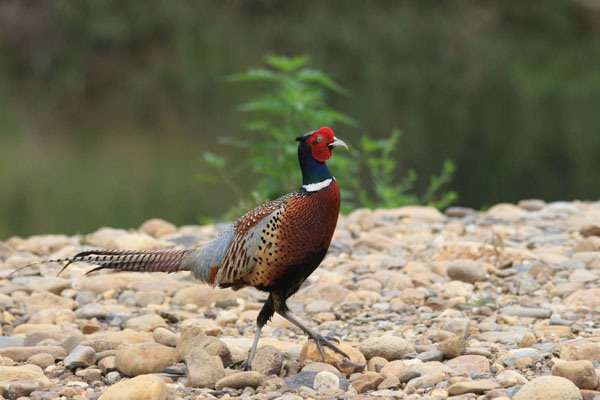Phasianus colchicus
IUCN
LCBasic Information
Scientific classification
- name:Phasianus colchicus
- Scientific Name:Ring-necked Pheasant,Common Pheasant,Pheasant
- Outline:Landfowl
- Family:Galliformes Phasianidae Phasianus
Vital signs
- length:590--868mm
- Weight:880-1650g
- lifetime:7-8 year
Feature
Pheasants have the advantages of beautiful appearance, firm and tender chicken, delicious taste and rich nutrition, fast growth rate and strong disease resistance.
Distribution and Habitat
In China, it is found almost everywhere except the Qiangtang Plateau in Tibet and Hainan Island. Abroad, it is distributed in Turkey, the Caucasus, Central Asia, Russia, Mongolia, the Korean Peninsula, etc. It has been artificially introduced to many countries and regions such as Europe, North America and Oceania, and has formed wild populations.
The habitat types are very diverse, and it is active in mountains, forests, shrubs, farmlands, grasslands, semi-deserts, and desert oases. The distribution altitude ranges from coastal mudflats to 3,000 meters. It is very concealed, and usually people will suddenly fly away when they approach, accompanied by rapid screams. During the estrus period, male birds often make loud "knock, knock" sounds, two at a time, accompanied by rapid flapping of wings, which can be heard from a long distance.
Appearance
The male has a variety of bright plumage colors such as red, yellow, and chestnut, with a white ring around the neck and a long tail with horizontal stripes. There are many subspecies and the plumage color varies greatly. Many eastern subspecies have gray waist feathers, and the white "collar" ranges from very wide to none. The Junggar subspecies in northern Xinjiang and the Shache subspecies in the south have copper-red waist feathers and white wing coverts. The female is slightly smaller, duller in color, earthy brown with dense dark spots all over the body, and is difficult to be found hidden in the bushes. The iris is brown, the beak is yellow-white, and the feet are gray.
Details
Pheasants are a kind of walking bird in the Phasianidae family of the class Aves, with a total of 30 subspecies. They are slightly smaller than domestic chickens, but their tails are much longer. The male and female birds have different feather colors. The male bird has gorgeous feathers with many metallic reflections. There is a bunch of ear feathers on both sides of the head that can stand up and the feathers are square-tipped. The edges of the feathers on the lower back and waist are scattered like hair; the wings are slightly short and round; there are 18 tail feathers, the tail is long and gradually becomes pointed, the central tail feathers are much longer than the outer tail feathers, and the edges of the male bird's tail feathers are separated like hair; the male bird has a short and sharp spur on the tarsus, which is a weapon for fighting and attacking. In recent years, it has been found that the length of the spur is significantly related to the number of mates it has, which is an important criterion for female birds to choose mates.
Pheasants have strong feet and are good at running, especially running very fast in the bushes, and are also good at hiding. After seeing people, they usually run fast on the ground and quickly enter the nearby jungle or bushes. Sometimes they run for a while and stop to look before walking. They take off only when they have to, making "cluck cluck" sounds and "fluttering..." sounds of their wings while flying. The flying speed is fast and powerful, but the flight is generally not sustained and the flying distance is not large. It often flies in a parabolic shape and glides before landing. After landing, they quickly run and hide in the bushes and grass, and rarely take off again. Sometimes they suddenly fly again when people walk in front of them. In autumn, they often gather in small groups of several to more than 10 to enter farmland, forest edges and villages to move around and forage.

Omnivorous. The food they eat varies with the region and season: in autumn, they mainly feed on fruits, seeds, plant leaves, buds, grass seeds and some insects of various plants; in winter, they mainly feed on tender buds, twigs, grass stems, fruits, seeds and grains of various plants; in summer, they mainly feed on various insects and other small invertebrates and tender buds, berries and grass seeds of some plants; in spring, they eat newly sprouted tender grass stems and leaves, and often go to the cultivated land to eat the seeds and seedlings of the millet planted.
Pheasants are polygynous. When in heat, the male bird circles around the female bird, calling while walking, and sometimes running a few steps. When approaching the side of the female bird's head, the wing on the side close to the female bird droops, and the other side stretches upward, with the tail feathers upright and the crown feathers on the head erected, which is a typical side-type show-off.
Pheasants breed one nest a year, and two nests in the south. Each nest lays 6-22 eggs, and the number of eggs in the south is less, mostly 4-8 eggs. The eggs are different types, such as olive yellow, khaki, yellowish brown, blue-gray, and grayish white. The size of the eggs also varies greatly in different places in the north and south.








